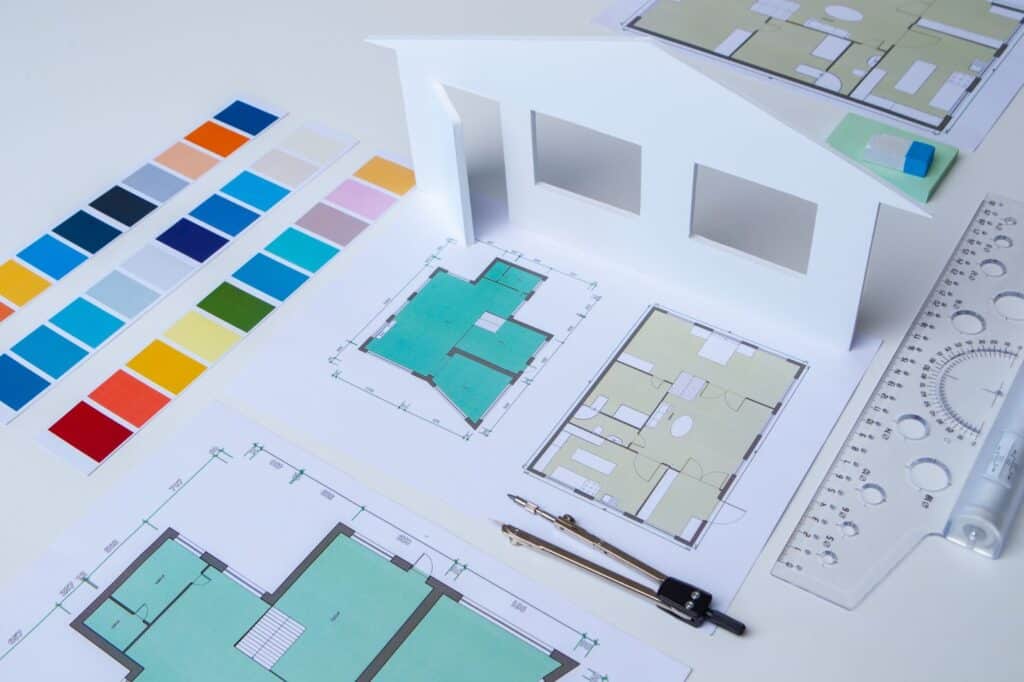In the fast-paced world of architecture and engineering, effective project management is the linchpin that holds everything together. But for many professionals in the field, managing projects can be an overwhelming task that consumes valuable time and resources. With various stakeholders, tight deadlines, and a plethora of details to juggle, architects and engineers often find themselves in need of better strategies and tools to streamline their project management processes.
In this ultimate guide, we aim to provide you with concrete strategies and practical insights to help you manage your projects more efficiently and conveniently. Whether you’re a seasoned architect or a budding engineer, our research-based content is designed to equip you with the knowledge and tools you need to thrive in the realm of project management. So, let’s dive in and explore the building blocks of successful project management for architects and engineers.

What is Project Management for Architects?
Project management in architecture involves overseeing the planning, design, and construction processes from beginning to end, ensuring that the architectural project is completed on time, within budget, and meets the required quality standards. This includes coordinating with various stakeholders such as clients, contractors, consultants, and team members, as well as managing resources, schedules, and any potential risks or issues that may arise during the project.
The project manager in an architectural project is responsible for setting objectives, defining roles and responsibilities, and establishing a clear communication plan. They also need to monitor the project’s progress, make necessary adjustments, and ensure that all parties are aligned with the project’s goals. In essence, project management in architecture is about bringing together different elements and people to create a cohesive and successful project outcome.
What Makes Project Management in Architecture Unique?
Project management in architecture is unique in several ways compared to other industries, primarily due to the nature of architectural projects and the specific challenges and requirements they entail.
Creativity and Aesthetics
Unlike engineering project management, which often prioritizes technical precision and efficiency, architecture heavily emphasizes creativity, aesthetics, and design. Managing an architectural project requires balancing creative aspirations with practical constraints like budget, timeline, and regulations.
Complex Stakeholder Collaboration
Architectural projects often involve a diverse range of stakeholders, from clients and contractors to consultants and suppliers. Each stakeholder has their own interests and contributions, and the project manager must ensure effective communication and collaboration between these varied groups.
Regulatory Compliance and Permits
Architecture projects must comply with a range of local, state, and federal regulations, including zoning laws, building codes, and safety standards. Obtaining the necessary permits and ensuring compliance adds an additional layer of complexity to project management in architecture.
Design Revisions and Changes
Architectural projects are often subject to design changes and revisions, which can be due to client requests, regulatory requirements, or other factors. These changes need to be managed carefully to ensure that they don’t negatively impact the project’s timeline or budget.
Sustainability and Environmental Considerations
There is a growing emphasis on sustainability and environmental considerations in architecture. This includes incorporating green building practices and ensuring that projects meet specific sustainability standards, which adds another dimension to project management.
In summary, project management in architecture is unique because it needs to balance creative and aesthetic considerations with practical constraints, manage complex stakeholder collaborations, navigate regulatory requirements, and handle design revisions, all while maintaining a focus on sustainability and environmental impact.

8 Tips For Effective Project Management in Architecture
Project management in architecture is a complex endeavor that requires careful planning and attention to detail. With the right strategy, however, architecture projects can be completed on time and on budget. In this section, we will provide eight tips for effective project management in architecture. From setting up an efficient workflow to learning how to use technology effectively, these tips will help you get the most out of your projects.
1. Start with Pre-Design
Pre-design is a crucial first step in the architectural project management process, laying the groundwork for a successful project outcome. To ensure this phase is executed effectively, consider the following advice:
In-Depth Client Consultation:
Start by scheduling multiple in-depth consultations with the client to fully understand their needs, expectations, and vision for the project. Use these discussions as an opportunity to clarify any ambiguities and ask questions that will help you gather the necessary information for the project.
Utilize Questionnaires and Surveys:
Consider creating detailed questionnaires and surveys for the client to fill out. This can help capture specific requirements and preferences that might be missed in verbal communication.
Comprehensive Site Analysis:
Invest time and resources in conducting a thorough site analysis. This should include an assessment of the site’s constraints, potentials, and any specific regulations or zoning laws that might affect the project. Use technology, such as drones or GIS mapping, to gather accurate and comprehensive data about the site.
Engage with Stakeholders:
Engage with other stakeholders, such as local authorities, community leaders, or neighboring property owners, to gather their insights and understand any external factors that might affect the project.
Documentation and Communication:
Document all the gathered information meticulously, ensuring that every detail is recorded accurately. Establish clear communication channels with the client and other stakeholders to keep them informed and engaged throughout the project.
2. Create a Work Plan
A well-structured work plan is instrumental in defining the project’s path. Start by clearly outlining the project’s objectives and scope, detailing exactly what the project will encompass and what it aims to achieve.
You also need to show who is on your team and what each person will do. Use a chart to make this clear. This chart will also help you list out the jobs and tasks for each team member, making sure everyone knows what they need to do.
Simultaneously, a responsibility matrix should be developed to explicitly outline the duties and tasks assigned to each team member. This ensures that all individuals are on the same page with regards to their specific roles and responsibilities. A preliminary project schedule must be drawn up to lay out the project’s milestones, deadlines, and overall timeline, with built-in buffer time to accommodate any unforeseen delays or changes that might arise.
Furthermore, the work plan must identify the preliminary staffing needs, specifying the number and roles of the team members required to bring the project to fruition. This must be accompanied by a project directory that lists the contact information of all team members, stakeholders, and other relevant individuals integral to the project.
Equally important is the inclusion of an internal project budget and profit plan that delineates the allocation of financial resources and the projected profit margins. Finally, if applicable, include any code Information or regulations pertinent to the project.
3. Effective Risk Management
Risk management is a critical component of architectural project management. Start by identifying potential risks that could impact the project, including financial risks, safety risks, and project delivery risks. Develop a comprehensive risk management plan that outlines strategies to mitigate these risks, including contingency plans for unforeseen challenges. Regularly review and update the risk management plan, ensuring it remains relevant and effective throughout the project’s duration. Learn more about managing risks in construction projects by visiting our blog.
4. Facilitate Productive Meetings
Effective meetings are pivotal in ensuring clear communication and keeping the project on track. For effective meetings that contribute to the project’s success, it’s important to consider the timing, structure, and follow-through. Start by scheduling meetings at times that are convenient for all participants to ensure maximum attendance. Prior to the meeting, send out an agenda to give participants a clear understanding of what will be discussed and allow them to prepare any necessary materials or questions.
During the meeting, respect everyone’s time by starting and ending the meeting as scheduled. Stick to the agenda to keep the discussion focused and on track. It’s also helpful to assign someone the role of note-taker to document the key points discussed, as well as any action items or decisions made. This documentation serves as a valuable reference to keep everyone aligned on the project’s next steps and responsibilities. By following these guidelines, meetings can be a productive tool in maintaining clear communication and keeping the project moving forward.

5. Track the Project’s Progress
Tracking the project’s progress is key to ensuring it stays on schedule and within budget. Regularly review and update the budget to account for any changes or unexpected expenses. Monitor the project’s progress against the timeline and adjust as necessary to keep the project on track. Utilize project management tools to keep a close eye on the completion of tasks and milestones. By consistently tracking budgets, timelines, and work completion, architects can proactively address any issues that arise, ensuring a smoother path to project completion.
6. Project Completion
Closing out an architectural project effectively is just as crucial as its initial planning and execution phases. Upon project completion, it is vital to conduct a thorough walkthrough with the client to ensure all aspects of the project meet their expectations and the agreed-upon specifications.
Address any remaining minor adjustments or corrections as necessary. Next, ensure all project documentation is complete, including as-built drawings, warranties, and maintenance instructions. It’s also important to gather feedback from the client and the project team, reflecting on what worked well and areas for improvement. This feedback is invaluable for future projects. Finally, archive all project documents and materials in an organized manner for future reference.
7. Continual Learning and Development
In the fast-evolving field of architecture, it is essential to stay updated on the latest trends, technologies, and best practices. Encourage continual learning and development within the project team by providing opportunities for education and professional growth. Attend workshops, webinars, and conferences to gain insights from industry experts and learn about new tools and methodologies that can improve project management processes.
8. Foster Strong Relationships
Building and maintaining strong relationships with clients, contractors, and other stakeholders are key to the success of any architectural project. Establish clear and open lines of communication, ensuring all parties are aligned with the project’s goals and expectations. Build trust by being transparent, meeting commitments, and delivering high-quality work. Strong relationships not only contribute to the success of the current project but also pave the way for future collaborations.

These principles can also be adapted for construction project management, where the focus is on efficiently guiding a project from its groundbreaking to completion.
For further reading, check out our blog on construction project delivery methods.
What makes a successful project manager?
Effective project management in architecture requires a specific set of skills to navigate the complexities and challenges of bringing a design from concept to reality. Here are some of the essential skills required:
Time Management
A project’s timeline is its backbone. Successful project managers meticulously plan each phase, set achievable milestones, and ensure that the team adheres to the schedule. They’re adept at juggling multiple tasks, re-prioritizing as necessary, and handling unexpected delays with a cool head.
Communication
Clear, transparent, and timely communication is the cornerstone of any successful project. This involves not just talking, but more importantly, listening. A project manager acts as a conduit, ensuring that the client’s vision is accurately translated to the team, and that any feedback, concerns, or updates flow seamlessly among all stakeholders.
Leadership
A successful project manager must be a strong leader who can motivate and guide the project team to achieve the project objectives. This involves providing direction, setting clear expectations, and addressing any challenges that may arise.
Problem-Solving
Challenges and roadblocks are par for the course in any project. The mark of a skilled project manager lies in their ability to dissect a problem, weigh the possible solutions, and implement the most effective one promptly.

Negotiation
Negotiation skills are important in managing relationships with clients, contractors, and other stakeholders. This involves finding mutually beneficial solutions that meet the project’s objectives while also satisfying the needs of all parties involved.
Financial Management
With an eagle eye on the budget, a project manager ensures that every penny is accounted for. They take proactive measures to mitigate financial risks and are always on the lookout for opportunities to optimize the budget.
Utilizing the Right Software
Project management software is an essential tool that can help streamline the project’s workflow, from scheduling and task management to document storage and communication. The right software will allow project managers to keep all project information organized and accessible, facilitating easier collaboration among team members. More on this below.
If you’re an engineer, you might find our guide to the best engineering project management software helpful.
Adaptability
The only constant in architecture is change. A successful project manager embraces this reality, staying abreast of industry trends, being receptive to new ideas, and demonstrating a willingness to course-correct when necessary.

Tools for Architecture Project Management
Leveraging the right tools can significantly streamline processes and enhance efficiency for an architectural project manager. Here are some project management tools that can make things easier for architects:
Project Management Software
A comprehensive project management software can serve as the central hub for all project-related activities. It can help manage schedules, track tasks, facilitate communication among team members, and store all relevant project documents in one place. Such software often includes features such as Gantt charts, task lists, and collaboration tools that enhance visibility and accountability.
Expense Tracking Tools
Managing project expenses is critical to staying within budget. Expense tracking tools help in project management tasks by monitoring costs, tracking receipts, and generating financial reports. These tools allow project managers to have real-time insights into the project’s financial health, helping them make informed decisions and adjustments as needed.
Project Accounting Software
Tools that track and manage project-based financials are designed to handle the unique financial aspects of architecture firms. These tools can assist in creating detailed budgets, tracking financial performance, and managing invoices and payments. They provide a clear picture of the project’s financial status, ensuring that project managers can maintain control over the budget and financial risks.
Deltek Vantagepoint
Deltek Vantagepoint is an excellent example of a tool that combines all these capabilities, serving as a comprehensive solution for architectural project managers. It offers a range of features including project management, expense tracking, and project-based financials, all integrated into a single platform.
With Deltek Vantagepoint, architects and project managers can streamline their workflows, enhance collaboration, and ensure that their projects are completed on time and within budget. The tool provides a holistic view of the project, from scheduling and resource management to financial tracking and reporting, making it easier to manage all aspects of the project efficiently.
Final Thoughts
Project management in architecture is a complex and multifaceted endeavor that requires a strategic approach and the right set of tools. By understanding the unique challenges and nuances of managing architectural projects, architects and engineers can develop effective strategies to navigate these challenges and ensure project success.
The tips and steps outlined in this blog, from starting with pre-design and creating a work plan to facilitating productive meetings and tracking project progress, provide a solid framework for achieving efficient and convenient project management.
Moreover, leveraging the right tools, such as project management software, expense tracking tools, and project-based financials, can significantly streamline processes and enhance efficiency. If you’re looking to take your project management to the next level, we highly recommend exploring BCS Prosoft’s Deltek Vantagepoint consulting services. Our team of experts will help you navigate the complexities of project management and provide you with the tools and knowledge you need to succeed.
If you’re looking to lighten your burden by using tech, take a look at our list of the 10 best project management tools for architects.

Frequently Asked Questions
Can architects do project management?
Yes, architects can undertake project management responsibilities. However, depending on the size and complexity of the project, they may find it beneficial to designate a project manager. This allows the architect to focus on the design and creative aspects of the project, while the project manager handles the logistical, administrative, and coordination tasks.
What do architects use for project management?
Architects use a range of tools for project management, including project management software, expense tracking tools, and project-based financial tools. These tools help architects schedule tasks, monitor project progress, track expenses, and manage the project’s financials. Deltek Vantagepoint is an example of a comprehensive tool that combines these capabilities, providing architects with a single platform to manage all aspects of their projects.
Why is project management important for architects?
Project management is important for architects because it helps to ensure that the project is completed on time, within budget, and meets the client’s expectations. Effective project management also enhances collaboration and communication among team members, stakeholders, and clients. It provides a structured approach to managing the project’s resources, timelines, and deliverables, ultimately contributing to the project’s overall success.
Is PMP worth it for architects?
The Project Management Professional (PMP) certification can be a valuable credential for architects who want to enhance their project management skills and knowledge. The PMP certification is recognized globally and is a testament to the individual’s expertise in project management principles and practices.
However, the decision to pursue PMP certification should be based on the architect’s career goals and the specific requirements of their projects or clients. For some architects, the PMP certification may be an essential qualification, while others may find it less necessary.






